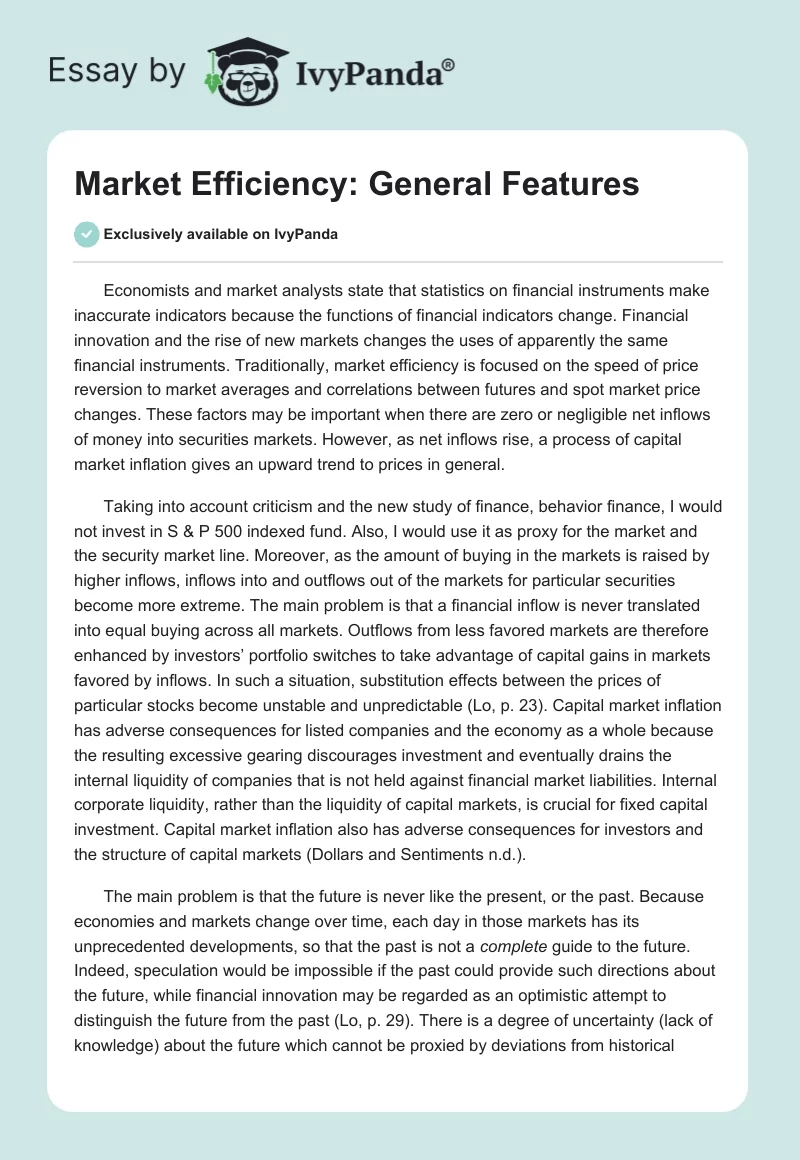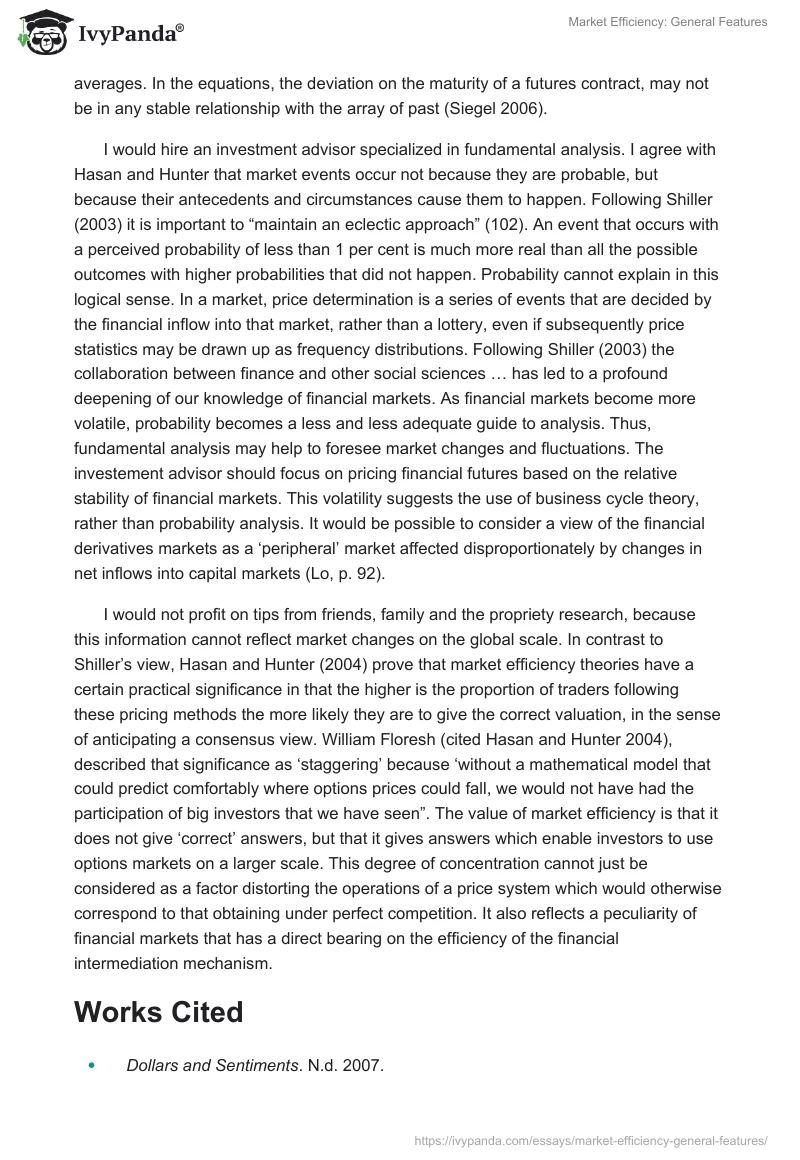Economists and market analysts state that statistics on financial instruments make inaccurate indicators because the functions of financial indicators change. Financial innovation and the rise of new markets changes the uses of apparently the same financial instruments. Traditionally, market efficiency is focused on the speed of price reversion to market averages and correlations between futures and spot market price changes. These factors may be important when there are zero or negligible net inflows of money into securities markets. However, as net inflows rise, a process of capital market inflation gives an upward trend to prices in general.
Taking into account criticism and the new study of finance, behavior finance, I would not invest in S & P 500 indexed fund. Also, I would use it as proxy for the market and the security market line. Moreover, as the amount of buying in the markets is raised by higher inflows, inflows into and outflows out of the markets for particular securities become more extreme. The main problem is that a financial inflow is never translated into equal buying across all markets. Outflows from less favored markets are therefore enhanced by investors’ portfolio switches to take advantage of capital gains in markets favored by inflows. In such a situation, substitution effects between the prices of particular stocks become unstable and unpredictable (Lo, p. 23). Capital market inflation has adverse consequences for listed companies and the economy as a whole because the resulting excessive gearing discourages investment and eventually drains the internal liquidity of companies that is not held against financial market liabilities. Internal corporate liquidity, rather than the liquidity of capital markets, is crucial for fixed capital investment. Capital market inflation also has adverse consequences for investors and the structure of capital markets (Dollars and Sentiments n.d.).
The main problem is that the future is never like the present, or the past. Because economies and markets change over time, each day in those markets has its unprecedented developments, so that the past is not a complete guide to the future. Indeed, speculation would be impossible if the past could provide such directions about the future, while financial innovation may be regarded as an optimistic attempt to distinguish the future from the past (Lo, p. 29). There is a degree of uncertainty (lack of knowledge) about the future which cannot be proxied by deviations from historical averages. In the equations, the deviation on the maturity of a futures contract, may not be in any stable relationship with the array of past (Siegel 2006).
I would hire an investment advisor specialized in fundamental analysis. I agree with Hasan and Hunter that market events occur not because they are probable, but because their antecedents and circumstances cause them to happen. Following Shiller (2003) it is important to “maintain an eclectic approach” (102). An event that occurs with a perceived probability of less than 1 per cent is much more real than all the possible outcomes with higher probabilities that did not happen. Probability cannot explain in this logical sense. In a market, price determination is a series of events that are decided by the financial inflow into that market, rather than a lottery, even if subsequently price statistics may be drawn up as frequency distributions. Following Shiller (2003) the collaboration between finance and other social sciences … has led to a profound deepening of our knowledge of financial markets. As financial markets become more volatile, probability becomes a less and less adequate guide to analysis. Thus, fundamental analysis may help to foresee market changes and fluctuations. The investement advisor should focus on pricing financial futures based on the relative stability of financial markets. This volatility suggests the use of business cycle theory, rather than probability analysis. It would be possible to consider a view of the financial derivatives markets as a ‘peripheral’ market affected disproportionately by changes in net inflows into capital markets (Lo, p. 92).
I would not profit on tips from friends, family and the propriety research, because this information cannot reflect market changes on the global scale. In contrast to Shiller’s view, Hasan and Hunter (2004) prove that market efficiency theories have a certain practical significance in that the higher is the proportion of traders following these pricing methods the more likely they are to give the correct valuation, in the sense of anticipating a consensus view. William Floresh (cited Hasan and Hunter 2004), described that significance as ‘staggering’ because ‘without a mathematical model that could predict comfortably where options prices could fall, we would not have had the participation of big investors that we have seen”. The value of market efficiency is that it does not give ‘correct’ answers, but that it gives answers which enable investors to use options markets on a larger scale. This degree of concentration cannot just be considered as a factor distorting the operations of a price system which would otherwise correspond to that obtaining under perfect competition. It also reflects a peculiarity of financial markets that has a direct bearing on the efficiency of the financial intermediation mechanism.
Works Cited
- Dollars and Sentiments. N.d. 2007.
- Hasan, I. Hunter, W.C. Bank and Financial Market Efficiency: Global Perspectives, Volume 5. JAI Press; 1 edition, 2004.
- Lo, A. Market Efficiency: Stock Market Behaviour in Theory and Practice. Edward Elgar Publishing Ltd, 1997.
- Siegel, J.J. The ‘Noisy Market’ Hypothesis. The Wall street Journal Online, 2006.
- Shiller, R.J. From Efficient market Theory to Behavior Finance. The Journal of Economic Perspectives 2003. Online.


